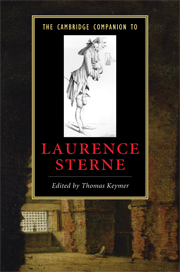Book contents
- Frontmatter
- Introduction
- 1 Laurence Sterne’s life, milieu, and literary career
- 2 Scriblerian satire, A Political Romance, the ‘Rabelaisian Fragment’, and the origins of Tristram Shandy
- 3 Tristram Shandy, learned wit, and Enlightenment knowledge
- 4 Tristram Shandy and eighteenth-century narrative
- 5 The Sermons of Mr. Yorick: the commonplace and the rhetoric of the heart
- 6 A Sentimental Journey and the failure of feeling
- 7 Sterne’s ‘politicks’, Ireland, and evil speaking
- 8 Words, sex, and gender in Sterne’s novels
- 9 Sterne and print culture
- 10 Sterne and visual culture
- 11 Sterne and the Modernist Moment
- 12 Postcolonial Sterne
- Further reading
- Index
- Series List
9 - Sterne and print culture
Published online by Cambridge University Press: 28 January 2010
- Frontmatter
- Introduction
- 1 Laurence Sterne’s life, milieu, and literary career
- 2 Scriblerian satire, A Political Romance, the ‘Rabelaisian Fragment’, and the origins of Tristram Shandy
- 3 Tristram Shandy, learned wit, and Enlightenment knowledge
- 4 Tristram Shandy and eighteenth-century narrative
- 5 The Sermons of Mr. Yorick: the commonplace and the rhetoric of the heart
- 6 A Sentimental Journey and the failure of feeling
- 7 Sterne’s ‘politicks’, Ireland, and evil speaking
- 8 Words, sex, and gender in Sterne’s novels
- 9 Sterne and print culture
- 10 Sterne and visual culture
- 11 Sterne and the Modernist Moment
- 12 Postcolonial Sterne
- Further reading
- Index
- Series List
Summary
Although Laurence Sterne would not have used the phrase 'print culture', he had a developed conception of the constellation of socio-economic and aesthetic factors clustered around the print medium, and he understood how to exploit these in an authorial career based on, though extending beyond, his literary work on the page. Sterne's expressions, in his letters and published work, of his awareness of the opportunities made possible by print allow us to define 'print culture' in his own terms. The main categories by which he recognised print culture were both public and private, combining an acute awareness of the market for literary works - the power of public opinion and the tools (patronage, reviews) by which a reading public is created and maintained - with a philosophical conception of the existential implications of printed expression for notions of individuality and originality. For Sterne, print culture manifested itself in three basic categories: fame (the social phenomenon of the celebrity), finance (the business of professional authorship), and physicality (the printed artefact). Both the social-cultural aspects of print culture (fame and finance) and the concretely material (physicality) mark an intersection of public and private. Not only is the print marketplace a locus of exchange where private written expression is made public; the printed text itself is also, for Sterne, a place where author and reader interact, and a point of contact that reveals the unbridgeable gap between participants in the act of communication.
- Type
- Chapter
- Information
- The Cambridge Companion to Laurence Sterne , pp. 125 - 141Publisher: Cambridge University PressPrint publication year: 2009
- 4
- Cited by

